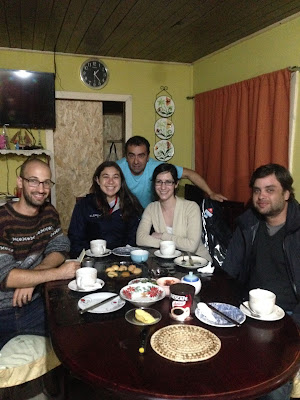 |
| The view of Quinchao from Dalcahue |
 |
| Overlooking the town of Achao |
Ancud
Coming from Santiago, we flew into the local mainland hub (Puerto Montt) and drove from there, via ferry, to the northern tip of Chiloe. We spent our first night in Ancud, Chiloe's northernmost city. Ancud is a pretty small city, but we made the most of our time there by eating Chiloe's signature dish: curanto en hoyo. Curanto is a "soup" of shellfish, sausage, chicken, ham, milcao, and chapalele. Milcao is a doughy potato patty and chapalele is similar, but contains wheat flour. Curanto is traditionally prepared in a hole in the ground and cooked over hot stones, so there is no broth. Instead broth is served on the side to be drunk before, after, or during the meal.
We also took a chance on a night time mythology tour, thinking it would involve a walk around the city and some ghost stories. Instead, at 11PM we were picked up in a van and driven out of the city and into a native forest, where a local took us on a walk through the dark woods. The path was lined with statues of the island's mythical creatures: witches, invunches (deformed infants who guard the witches' cave), and voladoras (the witches' messengers, who vomit up their intestines to transform into birds at night). The path is also used during the day for a local flora and fauna tour, so when we stopped every 20 minutes or so we had to wait to see if our guide's flashlight would reveal a gruesome mythical monster, or a placard describing a native bird. At the end of the tour, we were invited inside for tea and homemade jam and a chat with our guide and the van driver.
 |
| A 2am snack in our tour guide's home |
Castro
Castro is Chiloe's largest city and is very centrally located- ideal as a home base for exploring the island. It is known for palofitos- houses on stilts that raise them up above the water during high tide. Castro has a wider variety of restaurants than Ancud, including some upscale ones that cater to foreigners. At one, we enjoyed a cheesy king crab lasagna, and at another we ordered altogether too many mussels.
 |
| Kayla on her 4th!? ceviche of the trip |
Dalcahue
 |
| The craft market originally lured us to Dalcahue, but the seafood kept us around for hours and even warranted a second visit! |
Only a 20 minute drive from Castro, the small town of Dalcahue is a major hub where artisans and fisherman from the smaller islands of the Chiloe archipelago gather to buy and sell there wares. We enjoyed stopping here for the craft market, fresh cheese, and fresher seafood. 3000 pesos (~$4.50) bought as much sea urchin as we could eat. When asked where the urchin came from, the vendor pointed at the channel between Dalcahue and the nearest island and said "right over there." Divers harvested it that morning, and we watched her open it. Inside the sea urchins was a shock: tiny parasitic crabs, called Pancora, living within the urchins. The vendor explained that these are snack to be enjoyed in moderation, as they are high in iodine. You also aren't supposed to rinse them off before consuming, as this "washes away" some of the flavor!? We all tried one- you press them to the roof of your mouth to suck out the briny juice, and then spit out the husk. Our verdict: pretty good, for a once in a while snack.
After exploring Dalcahue, we drove onto yet another ferry to take us to the neighboring island of Quinchao. 3 days into Chiloe and we've ridden boats everyday!
In Quinchao, we drove to the oldest church in Chiloe. Chiloe is known for its old wooden churches and boasts 30+... some tourists come here to conquer the "Ruta de Las Iglesias" and visit them all. It's a funny contrast with all the talk of witchcraft and mythology on the island. Seems like you had to pick a camp and stick to it back in the day. If we were different people, this blog might be entirely dedicated to the churches of Chiloe. We refrained to two over our 5-day stay.
 |
| Fresh oysters- the plate for $5,000 CLP or $7USD |
 | ||
Karen accidentally ordered Kayla a "poto" (butt) of urchin instead of a "pote" (container). The vendor didn't even blink twice :0
|
 |
| Pancora, Pancora, Pancora |
| Following Matt's lead |
After exploring Dalcahue, we drove onto yet another ferry to take us to the neighboring island of Quinchao. 3 days into Chiloe and we've ridden boats everyday!
In Quinchao, we drove to the oldest church in Chiloe. Chiloe is known for its old wooden churches and boasts 30+... some tourists come here to conquer the "Ruta de Las Iglesias" and visit them all. It's a funny contrast with all the talk of witchcraft and mythology on the island. Seems like you had to pick a camp and stick to it back in the day. If we were different people, this blog might be entirely dedicated to the churches of Chiloe. We refrained to two over our 5-day stay.
 |
| The woodworking techniques present in these churches originate from boat-building. |
 |
| The Andes dotting the horizon were a fun twist on the island scenery. |
 |
| Kayla pleased to take a driving break in the passenger seat. |




No comments:
Post a Comment
Note: Only a member of this blog may post a comment.